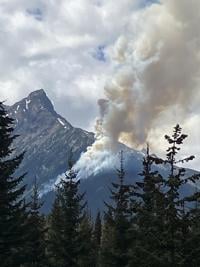LAHAINA, Hawaii (AP) — Josephine Fraser worried her young family's next home would be a tent.
Fraser and her partner, their two sons and their dog had moved nine times in as many months, from one hotel room to another, since the in a century razed her hometown of Lahaina, on Maui. They would sometimes get just 24 hours to relocate, with no immediate word where they were headed.
Now, the Red Cross was warning that the hotel shelter program would soon end and Fraser was having trouble explaining to her 3-year-old why they couldn't just go home.
“He just kept asking, ‘Why?’" she said. "It really broke me.”
Like Fraser, thousands on Maui have faced a year of since the Aug. 8, 2023, wildfire brought of destruction to Lahaina, the historic former capital of the Hawaiian kingdom, forcing some survivors to flee into the ocean. The fire killed and displaced 12,000.
Government and nonprofit groups have offered temporary solutions for displaced residents, including providing hotel rooms, leasing apartments, assembling prefabricated homes and paying people to take in loved ones.
Disaster housing experts say the effort, expected to cost more than $500 million over two years, has been unprecedented in its cooperation among federal, state, county and philanthropic organizations toward keeping the community together.
But on a tourism-dependent island where affordable homes were in short supply even before the fire, a housing market is undermining attempts to find long-term shelter for survivors even a year later.
Just about all of the 8,000 survivors put up in hotels have been moved into other accommodations, but many of those are pricey condos once rented to visitors, and they aren’t near residents’ jobs or their children’s schools.
Work to finish developments of temporary homes has been slowed by the difficulty of , obtaining materials from thousands of miles away, blasting and grading volcanic rock and installing water, sewer and electricity lines.
Members of at least 1,500 households have already left for other islands or states, some estimates say. Locals fear more will depart if they can’t find stable, affordable, convenient housing.
That's particularly painful for Hawaii, where leaders the islands are losing their culture as of Native Hawaiian and other local-born residents.
"You start to change the fabric of Hawaii,” said Kuhio Lewis, chief executive of the nonprofit Council for Native Hawaiian Advancement, which is involved in housing survivors. "That’s what’s at stake, is the future of who Hawaii is.”
Gov. Josh Green told The Associated Press in an interview that the state is building transitional and long-term housing, changing laws to convert 7,000 vacation rentals to long-term rentals and swiftly settling lawsuits by fire survivors so plaintiffs can get the money they need to start rebuilding.
“Will some people leave? Of course," Green said. “But most will stay, and they’ll really be able to stay if they get their settlements and can invest in their new houses.”
Plaintiffs and the state reached a on Friday, .
The Council for Native Hawaiian Advancement is building 16 modular units in Lahaina and 50 in Kahului, about an hour away, which kept Fraser and her family from winding up in a tent. In May, they moved into the first unit completed in Kahului, a small, white structure with two bedrooms and one bathroom.
The neighborhood remains a dusty construction site. The location is not convenient for her job as a manager at a hotel restaurant in Lahaina, but Fraser, 22, is grateful. She can cook for her kids and they can play outside.
“Everyone’s choice is to move out of Lahaina, to move off-island, to move to the mainland, and that’s not something that we want to do,” she said. “Lahaina is our home.”
Lahaina’s plight highlights an important question as human-caused increases the severity and frequency of natural disasters: How far should governments go to try to keep communities together after such calamities?
Shannon Van Zandt, with the Hazard Reduction and Recovery Center at Texas A&M University, said it's a worthy goal. Being a part of a community that supports its members is important not only to their livelihoods but their mental health, she said.
Jennifer Gray Thompson, the CEO of nonprofit fire-recovery initiative After The Fire, said she has worked in 18 counties that have suffered massive wildfires since 2017, when she herself lived through blazes that ripped through Northern California’s wine country.
Thompson has never before seen the Federal Emergency Management Agency invest so heavily in keeping a community together, she said.
“Maui is the first one I’ve ever seen the federal government fully listen to the community ... and actually really try to do what they were asking, which was to keep people on the island,” she said.
FEMA has focused on providing rentals for survivors who did not have insurance coverage for fire losses. The agency is directly leasing homes for more than 1,200 households and giving subsidies to 500 others to use on their own. Many of the rentals are in Kihei, 25 miles (40 kilometers) from Lahaina.
Still, the approach has proved tricky partly because vacation rentals and timeshares are one-quarter of the housing supply.
In October, FEMA by 75% to entice landlords to rent to locals. The agency is now paying $3,000 per month for a one-bedroom and more than $5,100 for a three-bedroom. People seeking housing on their own say that has inflated the rental market more.
Frustration over the after the fire prompted Maui’s mayor to propose in areas zoned for apartments. The measure is still under consideration.
FEMA also is constructing 169 modular homes next to a similar site being built in Lahaina by the state and the Hawaii Community Foundation. Residents begin moving into FEMA’s development in October. The $115 million project next to it will provide 450 homes for people who aren't eligible for FEMA; the first families arrive in the coming weeks. Residents begin moving into FEMA's development in October.
Bob Fenton, FEMA's regional administrator, told the AP the agency is even paying for survivors to fly elsewhere to live temporarily and to return when housing is ready.
“Our goal is the community’s goal," Fenton said. "We’ve tried to do everything we can to support that.”
Lucy Reardon lost the home her grandfather passed down to her and her brother. When July came, she was still living in a hotel with her partner and two children. She twice declined offers from FEMA to move off the island temporarily and provide her a car, she said, because her grandfather would have wanted her to stay.
Finally, the Council for Native Hawaiian Advancement moved her and her family into a two-bedroom apartment in West Maui, in the same building as her brother and his family.
“To get that phone call was like somebody reaching out with light,” Reardon said. Her daughter will be able to start kindergarten with her cousins at the school she would have attended before the fire.
The council also is paying people who take in displaced loved ones, providing $500 a month per guest. That has been helpful for Tamara Akiona, who bought a small condo in central Maui with her husband after she lost the multigenerational home where she lived with 10 family members in Lahaina. The money has covered food and other costs since they took in her uncle, Ron Sambrano.
“Without my family, I’d probably be living on the beach or under a bridge or something,” Sambrano said.
With stable housing, Fraser's family can begin finding a routine once again. She works during the day while her partner watches their sons. She returns to do dinner and baths before he leaves for his night shift as a restaurant server.
“It’s awesome to have a roof, somewhere to call home,” Fraser said. “At least for now, until we go back into Lahaina.”
___
McAvoy reported from Honolulu. Freelance journalist Mengshin Lin shot drone video accompanying this story.
Associated Press coverage of philanthropy and nonprofits receives support through the AP’s collaboration with The Conversation US, with funding from Lilly Endowment Inc. The AP is solely responsible for this content. For all of AP’s philanthropy coverage, visit .








































